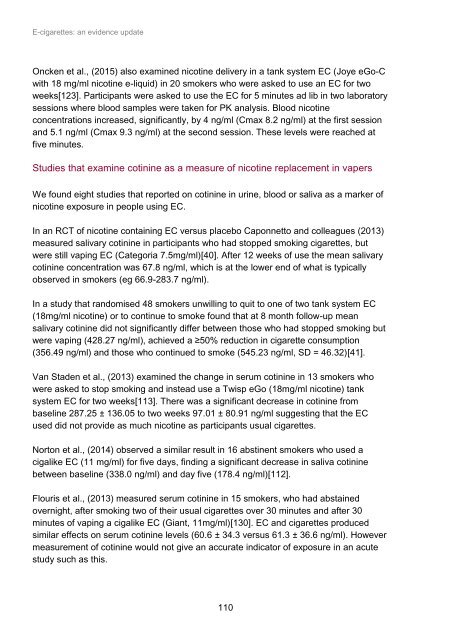E-cigarettes an evidence update A report commissioned by Public Health England
3nOaxpIe4
3nOaxpIe4
You also want an ePaper? Increase the reach of your titles
YUMPU automatically turns print PDFs into web optimized ePapers that Google loves.
E-<strong>cigarettes</strong>: <strong>an</strong> <strong>evidence</strong> <strong>update</strong>Oncken et al., (2015) also examined nicotine delivery in a t<strong>an</strong>k system EC (Joye eGo-Cwith 18 mg/ml nicotine e-liquid) in 20 smokers who were asked to use <strong>an</strong> EC for twoweeks[123]. Particip<strong>an</strong>ts were asked to use the EC for 5 minutes ad lib in two laboratorysessions where blood samples were taken for PK <strong>an</strong>alysis. Blood nicotineconcentrations increased, signific<strong>an</strong>tly, <strong>by</strong> 4 ng/ml (Cmax 8.2 ng/ml) at the first session<strong>an</strong>d 5.1 ng/ml (Cmax 9.3 ng/ml) at the second session. These levels were reached atfive minutes.Studies that examine cotinine as a measure of nicotine replacement in vapersWe found eight studies that <strong>report</strong>ed on cotinine in urine, blood or saliva as a marker ofnicotine exposure in people using EC.In <strong>an</strong> RCT of nicotine containing EC versus placebo Caponnetto <strong>an</strong>d colleagues (2013)measured salivary cotinine in particip<strong>an</strong>ts who had stopped smoking <strong>cigarettes</strong>, butwere still vaping EC (Categoria 7.5mg/ml)[40]. After 12 weeks of use the me<strong>an</strong> salivarycotinine concentration was 67.8 ng/ml, which is at the lower end of what is typicallyobserved in smokers (eg 66.9-283.7 ng/ml).In a study that r<strong>an</strong>domised 48 smokers unwilling to quit to one of two t<strong>an</strong>k system EC(18mg/ml nicotine) or to continue to smoke found that at 8 month follow-up me<strong>an</strong>salivary cotinine did not signific<strong>an</strong>tly differ between those who had stopped smoking butwere vaping (428.27 ng/ml), achieved a ≥50% reduction in cigarette consumption(356.49 ng/ml) <strong>an</strong>d those who continued to smoke (545.23 ng/ml, SD = 46.32)[41].V<strong>an</strong> Staden et al., (2013) examined the ch<strong>an</strong>ge in serum cotinine in 13 smokers whowere asked to stop smoking <strong>an</strong>d instead use a Twisp eGo (18mg/ml nicotine) t<strong>an</strong>ksystem EC for two weeks[113]. There was a signific<strong>an</strong>t decrease in cotinine frombaseline 287.25 ± 136.05 to two weeks 97.01 ± 80.91 ng/ml suggesting that the ECused did not provide as much nicotine as particip<strong>an</strong>ts usual <strong>cigarettes</strong>.Norton et al., (2014) observed a similar result in 16 abstinent smokers who used acigalike EC (11 mg/ml) for five days, finding a signific<strong>an</strong>t decrease in saliva cotininebetween baseline (338.0 ng/ml) <strong>an</strong>d day five (178.4 ng/ml)[112].Flouris et al., (2013) measured serum cotinine in 15 smokers, who had abstainedovernight, after smoking two of their usual <strong>cigarettes</strong> over 30 minutes <strong>an</strong>d after 30minutes of vaping a cigalike EC (Gi<strong>an</strong>t, 11mg/ml)[130]. EC <strong>an</strong>d <strong>cigarettes</strong> producedsimilar effects on serum cotinine levels (60.6 ± 34.3 versus 61.3 ± 36.6 ng/ml). Howevermeasurement of cotinine would not give <strong>an</strong> accurate indicator of exposure in <strong>an</strong> acutestudy such as this.110


